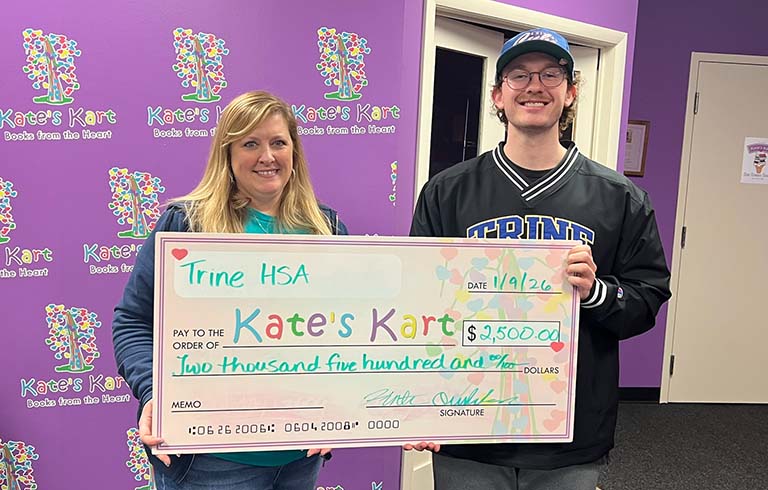
Trine’s Health Science Association donates to Kate’s Kart
Jennifer Nixon, left, program assistant with Kate’s Kart, accepts a $2,500 check for the organization from Hunter Overholser, president of Trine University’s Health Science Association (HSA).
November 07, 2019
By Earl D. Brooks II, Ph.D.
From its beginning, Trine University has sought to positively impact the community around it. Initially founded to meet the need for qualified teachers in the Angola area, the university has grown to provide qualified graduates across a wide variety of professions, including engineering, business and, more recently, the health sciences.
With more than 99 percent of Trine graduates employed or in graduate school within six months of Commencement, and an increasing number choosing to settle in the region, the university’s contribution to the region’s workforce is well-known. Similarly, Trine very visibly contributes to the culture and recreation of northeast Indiana by hosting programs such as concerts, open skating and camps. Both employees and students also serve the community through multiple volunteer opportunities.
Trine University’s economic impact may not be as apparent. However, the university’s effect on this area’s financial health is also a key element of the quality of place and quality of life for our region.
Recently, the Independent Colleges of Indiana (ICI) announced that, according to its latest economic impact study, its membership of 30 private institutions provided an impact of more than $5.4 billion on the state’s economy last year. Trine University is responsible for more than $135 million of that amount.
This impact is a natural outgrowth of the overall expansion Trine has experienced over the last 15 years. We now serve nearly 5,000 students each year and our physical plant has grown to well over $200 million in value, with recent building projects providing tens of millions of dollars in work for local construction companies, and an expansion to our engineering facilities coming soon. We welcome nearly 100,000 visitors annually to athletic competitions as well as the cultural and recreational programs mentioned earlier.
During our recent Homecoming celebration, more than 9,000 converged upon the Trine campus, but they benefitted many beyond Thunder Drive. Alumni and friends stayed in local hotels, bought gas, ate in local restaurants and checked out local stores as they reminisced about their time in Angola. Parents taking part in Family Weekend activities no doubt helped their students re-stock with essential supplies.
Such a multiplication of impact occurs with almost any activity hosted on university grounds.
In addition, the university is recognized as Angola’s largest employer by the Steuben County Economic Development Corporation. Think about the spending power of 550 full-time employees, in addition to many part-time workers. As they buy homes, cars and groceries, pay utilities and taxes, watch movies and eat at local restaurants, you can see how the numbers add up pretty quickly.
Though our primary focus is always on the education and success of our students, contributing to the economic development and vitality of the community is very important for Trine University. In addition to providing quality student interns and graduates who lead, succeed and serve in area businesses and organizations, we are proud to participate with area municipalities and economic development corporations on projects such as the Angola Innovation Park, and Trine innovation 1 continues to provide assistance to new and existing businesses in planning, prototyping and process improvement.
With continued growth expected, Trine University looks forward to making an even larger positive impact on Angola, Steuben County and the northeast Indiana region. Beyond contributing to the health of our campus, it is gratifying that our growth can benefit the communities so many of our employees, alumni and students call home.